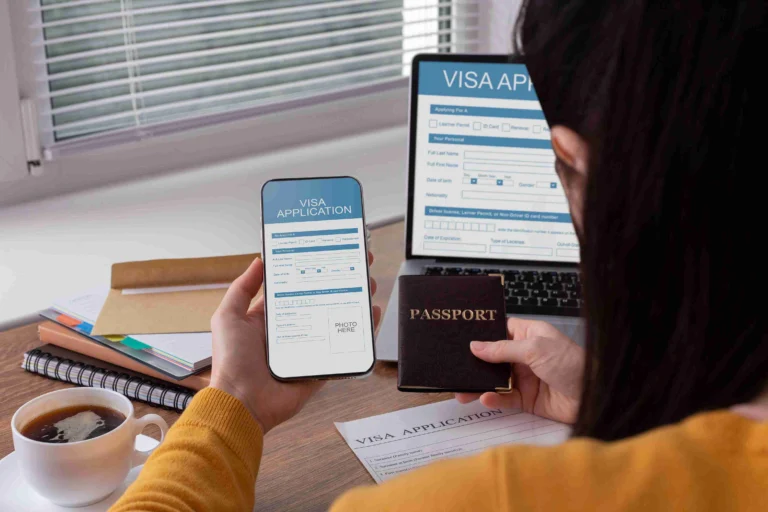
Australia Work Visa for Indians: Complete Guide to Skilled Migration
An Australian work visa for Indians is a chance to build a better career overseas with more job opportunities and international exposure. With the new Skills in Demand (SID) visa, Indian professionals can now experience faster application processing and easier pathways to permanent residency. Since Australia continues to need skilled workers in IT, healthcare, engineering, and trades, this is one of the best times for Indians to plan their move.
Overview of Australia Work Visa for Indians
What is an Australia Work Visa?
An Australia work visa for Indians allows qualified professionals to live and work legally in Australia. For most Indians, it opens opportunities to gain international exposure, earn higher salaries, and access better career growth.
There are different categories under which Indians can apply:
| Visa Name | Subclass Number | Description | Key Features |
| Temporary Skill Shortage (TSS) Visa | 482 | Previously, the main temporary skilled work visa has now been replaced with the Skill Demand visa | Employer sponsorship required, temporary visa |
| Skilled Independent Visa | 189 | For highly qualified professionals without sponsorship | Points-based, permanent residency, no employer sponsorship |
| Skilled Nominated Visa | 190 | Requires nomination by an Australian state or territory government | Points-based, state nomination required, permanent visa |
| Employer Nomination Scheme (ENS) Visa | 186 | Direct employer sponsorship for permanent residency | Employer sponsorship, permanent visa |
| Skills in Demand (SID) Visa | New (from 2024) | Replaces the TSS visa, aims to fill critical labour shortages | Multiple streams, employer sponsorship, and a clear PR pathway |
- Temporary Skill Shortage (TSS) Visa [Subclass 482]: Previously the go-to route, now replaced by the Skills in Demand Visa.
- Skilled Independent Visa [Subclass 189]: For highly qualified professionals without the need for sponsorship.
- Skilled Nominated Visa [Subclass 190]: Requires nomination by an Australian state or territory government.
- Employer Nomination Scheme (ENS) Visa [Subclass 186]: Direct employer sponsorship for permanent residency.
- Skills in Demand (SID) Visa [2024 onwards]: Designed to fill critical labour gaps across multiple sectors with clear PR pathways.
Having a valid visa secures rights like residency, access to healthcare (Medicare after PR), and, in many cases, the ability to bring family members. The right visa depends on your occupation, skills, and whether you have an employer sponsor or state nomination.
Confused about the right PTE score for PR and visas? Check out Australia PTE Score Requirement: Your Complete Guide now.
Advantages of the Australia Work Visa for Indians
- Age Limit: Applicants must be under 45 at the invitation time to ensure longer economic contribution and eligibility; employer-sponsored options may exist for those over 45.
- English Proficiency: 6.0 and more in IELTS (or any other options) is required since the higher the score, the more the points and the more chances of receiving a health visa.
- Points-Based Selection: The more points applicants get, the more invitations they are offered based on their age, education, work experience, and language skills.
- No Job Offer Needed: There are no skilled visa requirements that a prior job offer is required, which enables a greater amount of flexibility for migrants.
- Pathway to PR: A lot of skilled visas can result in Australia PR, which is long-term, stable, and advantageous.
- Multicultural Acceptance: Australia welcomes skilled foreigners of diverse origins, particularly Indians.
- Job Opportunities: Qualified migrants have various opportunities to get employment in high-demand jobs that have attractive remuneration.
- Family Benefits: Dependents can have access to social services and medical and educational facilities under visa terms.
This system aims to select skilled migrants who contribute effectively to Australia’s economy while offering a secure and prosperous lifestyle.
Eligibility Criteria for Indian Applicants
Getting approved depends on meeting the visa eligibility requirements of India. While streams differ, the general criteria include:
- Age: The majority of skilled migration visas are based on the requirement that the applicant must be below the age of 45 years upon invitation. This means that the applicants are at their productive working age and would contribute to the Australian economy in the long run. Citizens older than 45 years of age are often not eligible to apply in the independent skilled category, but can always seek employer-sponsored options.
- English Proficiency: A minimum English language requirement must be met, which is usually an IELTS score of at least 6.0 in each band (or equivalent in PTE/TOEFL). Higher scores can boost your total points for visas like subclass 189 and 190. For example, scoring IELTS 7.0 gives extra points, and a score of 8.0 can maximise your language points.
- Skills Assessment: A valid skills assessment from an authorised assessing body is mandatory. This verifies that your qualifications and work experience meet Australian standards. Examples include ACS (Australian Computer Society) for IT roles, Engineers Australia for engineering fields, and ANMAC (Australian Nursing & Midwifery Accreditation Council) for nursing professionals. Without this assessment, your application will not move forward.
- Work Experience: Relevant work experience in your nominated occupation is a great asset to your application. This means that experience of at least 3 years is required, with additional experience possibly getting you extra points. In the case of employer-sponsored visas, 2 years of work history in the nominated position can be sufficient, depending on the stream.
- Qualification: You should have a recognised degree, diploma or trade qualification that is similar to the standards of Australian education. For example, an Indian Bachelor’s degree in Computer Science is often accepted in jobs involving IT, although it must be accredited by a duly recognised board or university.
- Points Test (Subclass 189 & 190): The points test in Australia is crucial for skilled independent and state-nominated visas. Applicants need at least 65 points to qualify, but higher scores improve chances due to stronger competition. Points are awarded for:
- Age (maximum points between 25–32 years old)
- English proficiency (higher test scores = more points)
- Work experience (both in India and overseas)
- Educational qualifications
- Partner’s skills (if applicable)
- Nomination by a state (Subclass 190) adds extra points
Example: A 29-year-old IT professional with a Master’s degree, IELTS 7.0, and 5 years of experience can easily surpass the 70+ point mark, making them a strong candidate for skilled migration.
Use the Australia PR Points Calculator to quickly assess your eligibility and boost your chances of receiving an invitation for skilled migration!
Understanding the Australia Skills in Demand Visa
This new structure makes the Australia Skills in Demand visa more flexible for applicants, but to use it well, you need to know which occupations fall under each stream, especially the Core Skills list that covers most in-demand jobs.
What is the Skills in Demand Visa?
Australia rolled out the Skills in Demand Visa in December 2024 to directly address workforce shortages. It replaces the TSS visa and is more migrant-friendly. This visa offers:
- Pathways to PR: Clearer options compared to temporary visas.
- Increased Validity: Up to 4 years’ validity depending on stream.
- Mobility: More freedom to change employers without complex approval steps.
The SID visa has three streams:
- Specialist Skills Stream: For highly specialised jobs like software developers, AI experts, and advanced engineers.
- Core Skills Stream: Covers most job areas across IT, healthcare, trades, and education.
- Labour Agreement Stream: Reserved for workers employed under special government agreements.
This structure means that more Indian professionals, whether you’re in IT coding, nursing, or automotive trades, can now find a direct fit.
Eligible Occupations on the Core Skills List
The Core Skills Occupation List (CSOL), introduced in 2024, contains 456 occupations. This is a major expansion compared to previous short-term lists, which were often restrictive.
Some of the top in-demand jobs Australia has highlighted for Indian applicants include:
- IT & Tech: Software engineers, cybersecurity specialists, database administrators.
- Healthcare: Nurses, medical lab technicians, and aged care workers.
- Trades: Electricians, welders, plumbers, and automotive mechanics.
- Education & Science: Secondary school teachers, research scientists.
This expanded list allows Indians in a wider range of career fields to apply through the Australia Skills in Demand visa category without depending solely on employer sponsorship. If your occupation is on the core skills list in Australia, your chances of securing a long-term visa with PR pathways are now much higher.
Secure your Australian PR with ease! Read our guide: How to Get PR in Australia from India?
Step-by-Step Australia Work Visa Application Process for Indians
To increase your chances of approval, it’s important to follow each step carefully, from securing a sponsor or nomination to preparing all required documentation accurately.
Finding a Sponsor or Nomination
- Employer-Sponsored Pathway: An Australian company offers you a job that matches the occupation list.
- State/Territory Nomination: Indian professionals nominate through state-run programs like Victoria’s or NSW’s skilled visa programs.
Why this matters: A job offer matching the occupation list greatly strengthens your application and smoothens the process.
Skill Assessment and Documentation
Every Indian applicant must pass a skills assessment carried out by recognised bodies. For instance, IT professionals are assessed by ACS, while nurses undergo checks by ANMAC.
Common documents required for a work visa in Australia include:
- Valid Passport: The initial identification that you have is a passport. Ensure that it lasts at least 6 -12 months before you plan to travel. When your passport expires, renew it and then begin your visa applications.
- Skills Assessment Result: This is a required mandate in most skilled visas. This is an indication that you are qualified and experienced in Australia. The assessing body relies on your profession – such as ACS in the case of IT professionals, Engineers Australia in the case of engineers, and ANMAC in the case of nurses. And without this, your application will not go through.
- Employment Proof (Experience Letters and Payslips): These are some of the papers that confirm your past experience. The experience letters and payslips (salary proof) of your employer will help you demonstrate your professional history, which is of utmost importance not only to the points test but also to the verification of skills.
- Degree/Diploma Certificates: Educational credentials bear witness to your level of education. Your degrees or diplomas have to be from known institutes and similar to those in Australia. In some instances, transcripts can also be ordered.
- English Test Scores (IELTS, PTE Academic or TOEFL): English proficiency test scores will be mandatory, as in Australia, English is the language of work. Depending on the type of visa, minimum scores are determined; however, any score above that may contribute points to skilled migration.
- Medical and Health Test Results: All applicants are required to take health examinations by a panel of doctors who are authorised by the Australian government. This helps to ensure that the migrants are not a health hazard to the community and are healthy to work.
- Police Clearance Certificate (PCC): A background verification that you are not a criminal in India or any other country where you have lived in the past. This is needed by the Australian government to ensure safety at the community level.
📌 Pro Tip: Ensure your documents are accurate, as most visa rejections for Indians happen due to incorrect or missing documentation.
Lodge Visa Application Online
Applications are submitted through the official ImmiAccount portal. Important steps include:
- Create an account and select the correct visa type.
- Fill in the details carefully to match your documents.
- Upload scanned copies of certificates.
- Pay the application fee online.
Tip: Double-check spelling and dates before submission. Even minor errors can cause long delays.
Visa Fees and Processing Time
Typical visa application process in Australia costs:
- Skills in Demand Visa: AUD 1,455 – 3,210 (depending on the stream).
- Skilled Independent Visa (Subclass 189): Around AUD 4,910.
- Skilled Nominated Visa (Subclass 190): Around AUD 4,910.
Processing time:
- SID visas: 3–6 months (faster compared to older TSS).
- Skilled Independent/Nominated Visas: 6–12 months.
Post Visa Grant: Preparing to Move to Australia
After your visa is granted, understanding your rights and planning your move carefully can make your transition to Australia much smoother and stress-free.
Visa Conditions and Rights
Once you receive your Australia work visa, here’s what you can expect:
- Work Rights: Full-time employment in your nominated field.
- Travel Rights: Ability to travel in and out of Australia.
- Residency: Depending on the visa stream, you may apply for PR after a set period.
- Family: Many work visas allow dependent family members to accompany you.
Always read your Australian work visa conditions carefully to avoid unintentional breaches.
Planning Your Relocation
Moving from India to Australia is a big step. Proper planning makes the transition smoother:
- Health Insurance: Arrange coverage before arrival. Many employers include this, but check first.
- Accommodation: Start with short-term rentals or Airbnb before locking in long-term housing.
- Cost of Living: Major cities like Sydney and Melbourne are expensive, while Adelaide and Perth are more affordable.
- Local Registrations: Open a bank account, request a Tax File Number (TFN), and establish transport cards.
Thousands of Indians each year relocate successfully, and early planning helps you settle faster.
Are you a dentist looking to move abroad? Read our guide: How a Dentist Can Get PR in Australia
Conclusion
Getting an Australia work visa for Indians is now simpler than ever with the new Skills in Demand visa. With faster processing, clear PR routes, and an expanded core skills list, Australia offers Indian professionals excellent opportunities to build a successful future abroad. Ensure your skills assessment, English scores, and documents are ready, and with the right preparation, your Australian dream can soon become reality.
Need expert guidance? Contact VisaAxis at +91 72049 55253 and let our team help you secure the right visa and kickstart your journey to Australia.
Frequently Asked Questions (FAQs)
Q1. Which is the easiest work visa in Australia for Indians?
Ans. The Skills in Demand (SID) visa is the least complicated alternative as of today, as far as the majority of Indian professionals are concerned. The Core Skills stream of this visa is quite convenient because it encompasses quite a wide range of occupations, including IT, healthcare, engineering and trades. It also comes with faster processing time and long-term residence opportunities compared to the old visas. This particularly appeals to talented Indians who seek jobs abroad.
Q2. Would I need to have a job offer to apply for an Australia work visa?
Ans. Yes, Indians may apply for either a job offer in the Skilled Independent Visa (Subclass 189) or in the Skilled Nominated Visa (Subclass 190). These visas also demand that you undergo a skill assessment and that you come out well in the points test according to your age, experience, and qualifications. Though not mandatory, competition is stiff, and in that case, a high score on points will enhance your chances. In other types of visas, such as the SID or employer-nominated types, a job offer might still be required.
Q3. What is the time required to process the Australia Skills in Demand Visa?
Ans. The SID visa is a fairly short process, lasting 3 to 6 months as opposed to the older TSS visa. Processing time can vary depending on the stream you are using and the completeness and accuracy of the documents you have. Delays can be significantly reduced with all the paperwork in place at the start. Indians are already getting improved with streamlined online systems that enhance the process of approval among the Indian population.
Q4. What are the Australian work visa English language requirements?
Ans. The majority of Australian work visas require evidence of knowledge of English, e.g. an IELTS score of at least 6.0 in each band or equivalent scores in PTE Academic or TOEFL. But not only do higher scores satisfy requirements, but they also attract additional points under skilled migration visas (189/190). When it comes to professional workers, it is preferable to concentrate on IELTS 7.0 or even more in order to support their usage. The presence of test results that are valid prior to application accelerates the process.
Q5. Is my family able to go with me on an Australian work visa?
Ans. Yes, the majority of the skilled work visas give you the opportunity to bring your spouse and children into the application. Generally, your family members will be allowed to live, study and in most cases, they will also be allowed to work in Australia.



